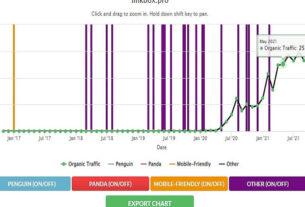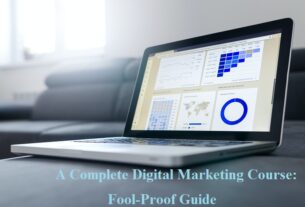Done right, affiliate marketing can be one of the most rewarding online businesses. But, like any other business model, you need to execute the right strategies to make it successful. In this guide, I’ll give you a tried and true process of how you can start and build an affiliate business from scratch.
Let’s get started.
What’s Affiliate Marketing Anyway?
Right now, affiliate marketing is one of the hottest business models out there. It’s when marketers promote products of other businesses in hopes to earn commissions. Every affiliate program has its own terms. Some pay affiliates based on sales while others just want you to generate leads for them.
For instance, Amazon Associates is an affiliate program of the world’s biggest e-commerce platform. Affiliate marketers from all around the world promote its products and earn pre-decided affiliate commissions. Similarly, there are subscription-based affiliate programs like Grammarly, where you get paid for every subscription you generate. The affiliate program gives you a personalized affiliate link and tracks it.
Benefits of Affiliate Marketing
No After-Sale Service
One of the most attractive benefits of affiliate marketing is that you don’t have to worry about the after-sale service. As soon as someone buys from your affiliate link, you get your commission. Everything else is taken care of by the brand or business you’re working with.
No Product Development
- As an affiliate, you promote what’s already out there.
- You don’t have to go through all the hassle of product development and launch.
No Inventory Costs
- You also get to make money without having to store a product and bear inventory costs.
Unlimited Income Potential
There’s no limit to how many affiliate programs you can join and make money with. And since most brands have an affiliate program, there are a lot of options to choose from.
Pick a Niche
Picking a niche is probably the most important step in affiliate marketing. You don’t want to promote everything under the sun. You’ll never build authority and no one will trust you let alone act on your affiliate offers. But, how do you pick a niche that’s profitable and not too competitive?
Explore Flippa
Flippa is an online marketplace where affiliate blogs are bought and sold all the time. By exploring Flippa, you’ll get a list of in-demand affiliate niches.
Pick a Micro Niche
- A micro niche is a niche within a broader niche.
- For instance, camping is a sub-niche in the broader outdoors niche.
- Similarly, the keto diet can be classified as a sub-niche of the broader health niche.
- Why narrow down though?
- Because a broader niche is going to be really tough to work on.
- For example, you have minimum to zero chances of outranking WebMD for health-related topics.
- So, what you can do is target a relatively smaller niche to decrease the competition.
Find Enough Long-Tail Keywords
Another factor to consider while picking a micro-niche is the number of keywords you can create content on. You don’t want to put your efforts into something that’s not scalable. What you can do is put your main keyword in Google Keyword Planner and note the total number of keywords it suggests. You need a few hundred keywords if you want to scale and expand it later.
Other free sources for long-tail keywords are Google’s:
- People Also Ask
- Related Searches
- Autocomplete
Sign Up for Affiliate Programs
Not all affiliate programs are made equal. You should work with the ones that are relevant to your niche, offer good enough commissions, and are legitimate.
Here are some reliable affiliate programs/networks you can join:
- CJ Affiliate
- Amazon Associate
- Impact
- AWIN
- Click Bank
Start a Niche Blog
Once you select your affiliate niche, it’s time to build a niche blog.
Choose a Fast and Reliable Hosting
Hosting is where your blog’s files are saved and managed. You want to pick a hosting service that’s fast and has great customer service.
Here are a couple of hosting services you can invest in with peace of mind:
- Namecheap (Ideal for beginners)
- Bluehost (Offers great bang for the buck)
Pick a Domain Name
You want to pick a domain name that’s:
- Relevant to your niche
- Easy to remember/recall
- Fairly short
- Preferably .com
Partial match domains work great if you can find a good one.
They have your niche keyword and an extra word, for instance, outdoorxyz.com.
Publish High-Quality Content
It might seem a little cliché but is still the king in all types of marketing. And as an affiliate blog owner, content should be your major investment. Without high-quality, SEO-focused content, you can’t expect to rank on Google, let alone generate affiliate sales.
Here’s how you can go about creating SEO-friendly content for your blog:
Write Engaging Headlines
Your headline should grab the reader by the throat and get them to read your blog post.
Make sure to front-load your headline with the target keyword as well.
Increase Your CTR with Powerful Meta Description
Ranking affiliate blog posts on the first page of Google is only half the battle. You also want to get them to click on your web page. So, write converting meta description since it’s shown under your title on search engine results pages.
Include Images
Visuals are incredibly helpful in keeping readers engaged with your posts. This, in turn, can improve your organic rankings as well as conversions.
Write Short Paragraphs
You never want to bombard the readers with lengthy paragraphs. Write short, easy-to-read sentences and paragraphs that make sense to most of your readers. Ideally, you want to keep your content friendly for a 6th standard student.
Spread the Word
As soon as you hit publish, promote your live link on social media and forums. It’d not only help you generate traffic but also diversify your backlink profile.
Create a YouTube Channel
Blogging isn’t the only way to promote affiliate offers. You can also use video marketing to build an audience and make affiliate commissions on autopilot. The good thing is you don’t have to show your face to make effective affiliate videos. Just make sure you add a lot of value to your videos with well-researched, helpful content.
Partner Up With Influencers
Influencer marketing is another great source of high-quality traffic. Find influencers in your niche, collaborate with them, and drive traffic to your affiliate links. However, this strategy is ideal for affiliates who can afford to invest.
Build an Email List
An email list can be another source of affiliate traffic. And unlike most traffic acquisition strategies, you own your email list, which gives you more control over it.
Although email list-building takes time, it’s incredibly rewarding. Your goal should be to reduce the reliance on a single source of income as much as possible.
You want to create multiple sources of traffic for your affiliate blog posts.
Always Optimize for Mobile
In this day and age, optimizing your blog for mobile isn’t an option.
Almost half of the internet’s traffic comes from mobile devices.
Thankfully, keeping your web pages mobile-friendly is super simple, especially if you’re using WordPress.
Just make sure you’re using a responsive theme.
Final Thoughts
Affiliate marketing can be incredibly profitable if you follow the right path.
You want to devise your own affiliate marketing strategy based on what’s working for top affiliates.
Here’s a quick recap of what we talked about in this affiliate marketing guide:
- Find a niche
- Grow a niche blog
- Work on a Niche YouTube channel
- Leverage influencer marketing
- Build your email list
- Keep your content optimized for mobile users
For more great content around affiliate marketing, explore this resource: forrestwebber.com



